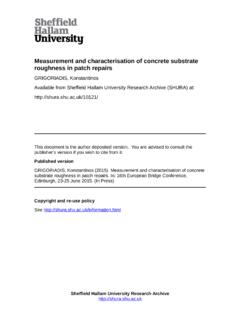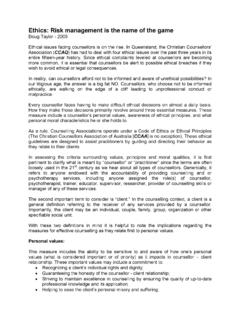Transcription of The longitudinal development of social and …
1 The longitudinal development of social and executive functions in late adolescence and early adulthoodTAYLOR, Sophie < >, BARKER, Lynne < >, REIDY, Lisa < > and MCHALE, SueAvailable from Sheffield Hallam University Research Archive (SHURA) at: document is the author deposited version. You are advised to consult the publisher's version if you wish to cite from versionTAYLOR, Sophie, BARKER, Lynne, REIDY, Lisa and MCHALE, Sue (2015). The longitudinal development of social and executive functions in late adolescence and early adulthood.
2 Frontiers in Behavioral Neuroscience, 9. Copyright and re-use policySee Hallam University Research RESEARCH published: 15 September 2015doi: in Behavioral Neuroscience | 2015 | Volume 9 | Article 252 Edited by:Niels Birbaumer,University of Tuebingen, GermanyReviewed by:Hans-Joachim Bischof,University of Bielefeld, GermanyLilian Konicar,Institute for Medical Psychology andBehavioural Neurobiology, Germany*Correspondence:Sophie J. Taylor,Department of Psychology, Sociologyand Politics, Sheffield HallamUniversity, Heart of the Campus,Collegiate Crescent, Sheffield S102BQ, June 2015 Accepted:31 August 2015 Published:15 September 2015 Citation:Taylor SJ, Barker LA, Heavey L andMcHale S (2015) The longitudinaldevelopment of social and executivefunctions in late adolescence andearly Behav.
3 Neurosci. 9 : longitudinal development ofsocial and executive functions in lateadolescence and early adulthoodSophie J. Taylor*, Lynne A. Barker, Lisa Heavey and Sue McHaleDepartment of Psychology, Sociology and Politics, Sheffield Hallam University, Sheffield, UKOur earlier work suggests that, executive functions and social cognition show protracteddevelopment into late adolescence and early adulthood (Taylor et al., 2013). However, itremains unknown whether these functions develop linearly or non-linearly correspondingto dynamic changes to white matter density at these age ranges.
4 Executive functions areparticularly in demand during the transition to independence and autonomy associatedwith this age range (Ahmed and Miller, 2011). Previous research examining executivefunction (Romine and Reynolds, 2005) and social cognition (Dumontheil et al., 2010a)in late adolescence has utilized a cross sectional design. The current study employed alongitudinal design with 58 participants aged 17, 18, and 19 years completing socialcognition and executive function tasks, Wechsler Abbreviated Scale of Intelligence(Wechsler, 1999), Positive and Negative Affect Schedule (Watson et al.)
5 , 1988), andHospital Anxiety and Depression Scale (Zigmond and Snaith, 1983) at Time 1 withfollow up testing 12 16 months later. Inhibition, rule detection, strategy generation andplanning executive functions and emotion recognition with dynamic stimuli showedlongitudinal development between time points. Self-report empathy and emotionrecognition functions using visual static and auditory stimuli were stable by age 17whereas concept formation declined between time points. The protracted developmentof some functions may reflect continued brain maturation into late adolescence and earlyadulthood including synaptic pruning (Sowell et al.
6 , 2001) and changes to functionalconnectivity (Stevens et al., 2007) and/or environmental change. Clinical implications,such as assessing the effectiveness of rehabilitation following Head Injury, are : adolescence, longitudinal , developmental trajectory, social cognition, executive functionIntroductionAdolescence is a critical period of development with dynamic brain maturation characterizedby psychological, behavioral and social change (Steinberg and Morris, 2001) indicative of thetransition to autonomy and independence.
7 Executive functions and socio-emotional developmentare key to adaptive functioning in this stage of development (Ahmed and Miller, 2011). Executivefunctions initiate, co-ordinate, maintain, and inhibit other cognitive functions (Miyake et al.,2000) and are recruited in novel or demanding situations to performgoal-directed behaviorwhen routine behavior is inadequate. social cognition incorporates a range of functions includingemotion recognition, empathy, perspective taking, and Theory of Mind (ToM), the ability toimpute a range of mental states including beliefs, desires, and intentions to self and othersTaylor et and executive functions in late adolescence(Frith, 2007; Carrington and Bailey, 2009).
8 During adolescencesome cognitive functions show protracted developmentincluding updating and switching (Magar et al., 2010),verbal fluency and planning (Romine and Reynolds, 2005),emotion recognition (Thomas et al., 2007), perspective taking(Choudhury et al., 2006; Dumontheil et al., 2010a), and empathy(Mestre et al., 2009). However, these data predominantly focuson younger age ranges with less known about late adolescentand early adulthood development . Furthermore, these studiesindicate linear development of cognitive functions whereasthereis also contrasting evidence of non-linear development (Tayloret al.)
9 , 2013).Findings from imaging studies indicate that brain maturationis dynamic across development including both progressive(myelination) and regressive (synaptic pruning) processes(Sowell et al., 2001) with protracted development of frontalnetworks into late adolescence and early adulthood (Schmithorstand Yuan, 2010). The continued development of frontal networksis particularly pertinent because they are thought to play animportant role in executive functions (Barker et al., 2010) andsome aspects of social cognition (Carrington and Bailey, 2009)that are crucial to adaptive goal-oriented behavior.
10 DiffusionTensor Imaging (DTI) data show protracted maturation offrontal networks (Schmithorst and Yuan, 2010) are associatedwith the executive function of strategy generation (Delis et al.,2001) between and years of age at Time 1 with follow-up testing 16 months later (Bava et al., 2010). These findingsindicate that white matter maturation in late adolescence andearly adulthood leads to an improvement of executive functionsand provide the neural basis of developmental change in certainaspects of FunctionsLate adolescence is characterized by linear and non-linearbrain maturation that may correspond behaviorally to functionsshowing linear or non-linear development , for example troughsand peaks in development (Fischer and Kennedy, 1997).

















